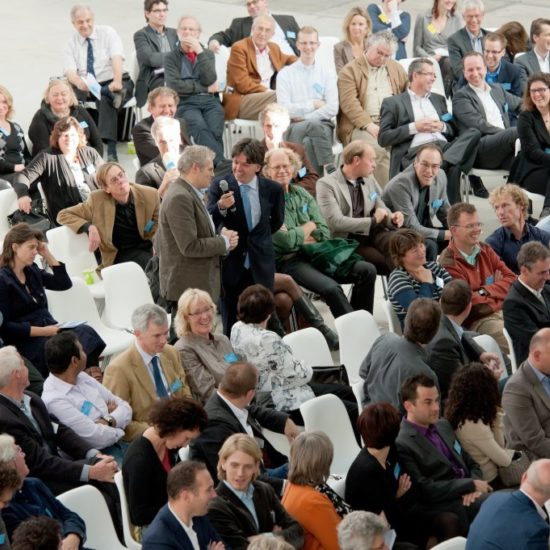YOM (Your Open Metaverse) organises monthly round tables with those who want to talk about this new world: the metaverse. For the first meeting in this series, 30 people gathered in Spatial for a panel dialogue on the economic side of the metaverse. We - Rick and JayJay - loved the experiment ánd gained some learnings and observations to share.
From the moderator perspective (Rick)
“To begin with, most rules of great moderation still apply online; just as the DNA of a great panel is basically the same for physical and online events.
Meeting in the metaverse comes with new difficulties, but I want to emphasise that the overall experience feels pretty real. Moving from a typical Zoom meeting to Spatial feels like moving from a grid to an actual room. Moreover, it’s amazing to have 3D objects, pictures and other files floating around. These features enable convenors and speakers to illustrate their messages in a myriad of new ways.
The multiple projector screens could also improve presentations, especially if you dedicate each screen to a separate task. Yet your avatar is in front of you, which comes with a downside. If you want to face your audience while you are presenting from the centre stage (of course you do: who would want their moderator to literally turn their back to the group?)... Then you are looking at the back of the pulled down screen. We noticed that the audience keeps seeing your avatar as if nothing happened, but you are unable to observe your participants at that point in time.
My main issue was that I couldn’t see who’s speaking. You see most avatars moving somewhat throughout the meeting, but you don’t know who they are and whether they move on purpose. In other words, there’s distractions everywhere, but where’s Wally? Only frontbenchers who move frantically drew my attention. Even with just 25% of virtual room capacity filled, you can hardly cast a glance beyond the front rows. This boils down to moderating while you’re blindfolded. So it’s more anonymous than a typical Zoom meeting.
For instance, I missed seducing the archetypical introverted backbencher or crossbencher to add their nuanced insights. (Bear in mind that I was still working on a regular laptop. Chances are that wearing VR gear would immerse you more with the event. And how about augmented reality features enabling you to give hugs, high fives and fist bumps to fellow speakers and participants?).
About half of the participants were geared up with VR headsets This comes with another challenge: avatar faces are static. As a result, regular laptop/smartphone/tablet users are more recognisable because their own videos are above their avatars. Usernames are also there, but the fonts should become way more legible to be useful. Now you need to ask every participant to mention their name before speaking. The other way around, to address participants you’re stuck with “you, yes you, blonde lady on the second row”.
My lesson learned: like online meetings require that you moderate more directively than physical meetings, virtual meetings require a similar leap. So to steer this seemingly steerless ship, do you need to move from directive to downright autocratic moderation? I’m still ambivalent about it: as you’re still in charge of the atmosphere, you need to make the meeting both clear and inviting.”
Through the eyes of the participant (Jay-Jay)
“As we learned from the pivot to online meetings, making a true connection is harder when you’re not physically together).
First of all, I felt quite lonely, even though the avatars are supposed to give you this feeling of being together. What doesn’t help is that you can’t see faces, there’s no body language to read and - more in general - there’s no particular atmosphere that allows you to read the meeting. This should be the first thing to focus on, when developing platforms like Spatial and when designing meetings in the metaverse.
Another annoying thing is that you can’t see who’s talking. It’s hard to see which pannellist has the mic, so you feel kind of lost. The current status of the metaverse is like listening to the radio, while being distracted by non-related visuals.
Finally, I’m one of those participants who wants to express himself and wants to join in the dialogue. This is very hard, because of two reasons. Firstly, raising your arm is an option, but it will only stay up for a second. So you find yourself pushing the button like a madman to draw attention. But more importantly: when you do get the mic, you have no clue whether your message/question gets across. You can’t see the moderator’s or speakers' faces and you miss the buzz in the room of fellow participants (dis)agreeing.
Conclusion (Rick and JayJay)
The metaverse seems to have tremendous potential for organising meetings. Yet, there’s a lot to be gained in terms of getting people to truly engage, interact and connect. In our view, there’s plenty of technical solutions ready to enrich such meetings. Along the way, we will learn and grow. For now, we want to leave you with our wish list for the near future:
- A chat for participants to interact throughout the meeting. Or maybe even the option to ‘whisper in each other's ear’;
- Visible names of participants.
- A spotlight on the participant who’s currently speaking. Or maybe even a soapbox option for participants to be spotlit visually in the space;
- Feature to show 3D objects
- A feature, allowing the moderator to ‘push’ participants in smaller groups, when he sees fit?
- How about allowing all participants (those with/without VR gear) to show their mood? Avatars with strong facial expressions and postures would humanise 3D meetings.
Most likely, the list will grow over time. Anyway, we are very much looking forward to further exploring ánd shaping the metaverse. We hope to see you there sometime.
Rick van der Kleij
Jan-Jaap In der Maur


